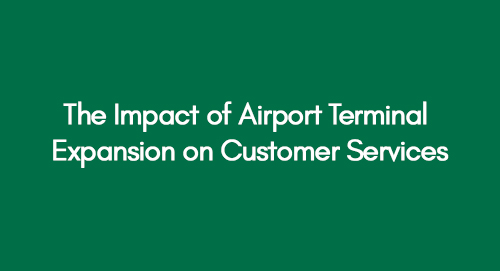
National Cyber Security Policy and Strategy of Ghana: A Qualitative Analysis
December 12, 2022
Is Traditional Pedagogy Still Effective In Today’s Modern Educational System?
December 13, 2022Explore how expanding airport terminals affects customer service. Discover the changes and improvements that come with airport expansion and how they influence traveller experiences. The Incheon Airport in South Korea is expanding its terminal, which is in the third development phase. The airport will be officially open in January 2018, aiming to address users' convenience at the main gateway of South Korea.
Customer Service on Customer Experience in Supermarket/Hypermarkets
This thesis seeks to analyse the impact of airport terminal expansion on customer services at Incheon Airport. For this study, primary data is collected from people visiting Incheon Airport in Korea, where this data is analyzed using regression analysis. The results showed that airport terminal expansion significantly positively impacts customer services at Incheon Airport. The thesis also provides recommendations to airport authorities to improve customer experience by delivering modified airport services.
Introduction
The following text comprises the background of the topic.
Background of the Topic
According to Jahanshani et al. (2014), customer service in any business forms the key to success while determining the organisation's overall sales and profits. Similar to other sectors, Jahanshani et al. (2014) opined that airports also require focusing on their customer services with the help of improving their service quality. On the other hand, the airport's infrastructure is the most important point of contact for tourists on their country’s trip. As a result, services need efficient processing at airports to maximise the time to travel while allowing leisure time in the commercial areas of airports (Martín-Cejas, 2006, p.874).
In the 2015 ACI Airport Quality Service Award rankings, more than 550,000 tourists worldwide saw their travel experience. They ranked airports ranging from check-in and on-site security and food, beverages and retail. Airports have evolved into complex business initiatives that take place independently and, in many cases, compete with each other for passenger transport. From dining and duty-free shops to the environment, cleanliness, courtesy of staff, convenience, efficiency and more, passengers expect big things from the airports they travel with.
The Incheon Airport in South Korea has started to expand as it invested $4.6 billion to increase passenger capacity by 41% in 2017 (Casemiro and Kim, 2015). This effort is made to better compete in the Asian race to become an important regional hub. To do so, Incheon Airport has joined its competitors, such as Changi Airport in Singapore, which has been expanding to capitalise on improved traffic in the Asian region. As a result, the Incheon Airport is also searching to accommodate an increased influx of travellers for the Winter Olympic Games in South Korea during 2018.
The following texts are related to the rationale of the study.
Rationale for Conducting the Study
As stated by Arif, Gupta and Williams (2013, p.5), customer services have played an important role in airport management as they form the core of airport services. Hence, meeting and understanding the varying needs as well as expectations of customers forms the major part of managing and operating airports successfully. In addition, the new perspectives of carrying out business in this century need airport authorities to think holistically regarding the various customer services. This is why customers have increased expectations about the service standard, where they expect their airport experience to be as enjoyable and effortless as possible.
In this regard, the expansion of airports plays an important role in offering good and quality customer services at large airports. The wide range of services customers will likely enjoy makes their travelling memorable and exciting. South Korea’s Incheon Airport is in its third phase of construction. The aim is to address the steady increase in airline demand from metropolitan areas while reinforcing the region's competitiveness with other airlines. For this expansion, nearly five trillion was invested from 2009-2017 to construct the airport's infrastructure such that all transportation facilities will be connected (Airport. kr, 2017).
Based on this premise, there is a need to study how this expansion of Incheon Airport will impact customer services, where customers are passengers who travel through this airport. Also, previous studies have mostly focused on the expansion effect of Heathrow Airport (Redondi and Gudmundsson, 2016, p.287; Smith, 2017, p.4). Hence, this study focuses on airport expansion's impact on Incheon’s airport customer services.
Research Objectives
To study the impact of airport terminal expansion on customer services at the Incheon Airport, the following research objectives are proposed for this study:
- To understand the concept of customer services in the airport context
- To evaluate the factors impacting customer services at airports
- To determine the impact of airport expansion in providing good customer service at Incheon Airport
- To provide recommendations to airport authorities of Incheon Airport for offering improved customer services through expansion.
Research Hypothesis
To study the impact of airport terminal expansion on customer services at the Incheon Airport, the following research hypothesis is proposed for this study:
Ho: There is no impact of airport terminal expansion on customer services at Incheon Airport
H1: There is a significant positive impact of airport terminal expansion on customer services at Incheon Airport
Literature Review
In the travel and transportation industry, airports have been experiencing continuous growth.
Overview of the Airport Industry
The study by Fu and Oum (2014, p.11) argued that the global aviation industry had maintained yearly growth rates of 6-7% over the last few decades, where greater than 3 billion passengers have passed through the different airports of the world during 2010. On the other hand, the region of Asia has appeared to be the leading region in the generation of aviation traffic in recent decades, accounting for nearly 30% of the total revenue passenger kilometres in the world (Poole, 2015), which was previously recorded at 24% during 2004. Asia, as the fastest growing region of the world, must consider its growth to become resilient at more than 6% yearly for the next decades. In contrast to this, Fu and Yang (2017, p.97) argued that airports in more developed regions, such as North America and Europe, are perceived to expect slow growth relatively while having scarce opportunities because of the maturity of the market, the concerns related to the environment, and the increased availability of substitutes including high-speed rail transport.
Therefore, researchers opined that the increase in demand for airport infrastructure in Asia could be explained with the help of three factors (Hirsh, 2016; Hakim and Merkert, 2016, p.120). These include a lack of alternative modes of transport in Asia (Hirsh, 2016), liberalization of Asian markets (Adler et al., 2014), and increased growth in the size and wealth of the middle classes in Asia (Ping, 2017). In addition, the opening of formally closed countries in Asia since the 1980s to worldwide trade has increasingly supported the movement of both people and goods in Asia. Not only this, Kim (2015, p.134) further highlighted that FTAs (free-trade agreements) have effectively driven the integration and convergence of economies within the Asian region and have improved trade between other regions. Parallel to this, visa requirements are also liberalized by Asian countries, liberalizing the agreements of air travel. Gootiizand Mattoo (2017, p.574), for instance, discussed that the continuous program of liberalization of ASEAN air services had ensued significant increases in flights between capital cities, and it has allowed the development of secondary airports to ASEAN flights during the year 2015 (Kim, 2015, p.134). In addition, the increased liberalization of travel restrictions in Asian economies has effectively supported the opportunities for travelling to new segments of the population where many people were not previously capable of travelling by air.
The study by Sarker, Khan and Mannan (2016, p.64) highlighted that Asia already has one of the largest shares of the total urban population in its cities, unleashing the wave of travelling in this region. This might be because people could easily travel because of the proximity to airport availability in these cities, and they could migrate to centres where they can get high salaries (Sarker, Khan and Mannan, 2016, p.65). These findings supported that the Asian region has become a higher-income region where approximately 41% of the middle class in the world lives. Such a proportion of the middle class in Asia is based on the prediction that the world’s middle class will increase to 68% in 2033 (Birdsall, 2015, p.217). On the other hand, scientific studies also depicted that the consumer’s inclination for travelling increases with the improved economic well-being of the country (Lamsfus, 2015, p.217; Horner and Swarbrooke, 2016). This was also supported by Van De Vijver, Derudder and Witlox (2014, p.142), who stated that there is a more compelling case for air travel growth in Asia. Asians, compared to North Americans and Europeans, take more trips at the same levels of economic well-being.
One of the important reasons attributed to the above-stated notion could be related to the lack or absence of alternative transportation modes. Compared with North America and Europe, larger parts of the Asian region could be reached just by air. V Van De Vijver, Derudder and Witlox (2014, p.142)also found that geographical barriers, such as the island nature of Southeast Asia, mountainous regions, and increased distance between major cities of Asia, also contributed to airport development in the region. Although high-speed rail is well-developed in North Asia, such as China, travelling by air remains a viable option for the perspective of time and cost shortly. To fully respond to this demand, the current fleet of aircraft in Asia must grow rapidly. This would be equalled to nearly new deliveries of 13000 jets in the next twenty years, double the size of the current fleet (Lee, 2016, p.217).
Customer Service at Airports
For airports, customer service is the core value concerning passengers and organizations, the airport staff, the non-travelling public, and others that make the customer base of airports. Vasigh and Fleming (2016) argued that meeting and understanding the different needs of airport customers is a major part of running airports successfully. On the other hand, Misopoulos et al. (2014, p.705) opined that airlines, until recently, were held responsible for most of the customer service during the flight period of a passenger. However, this trend has shifted to a great extent in recent years. This is because more and more airports have effectively realized the significance of offering the best possible flight experience for their customers who travel through their terminals. As a result, they have been making efforts to provide a comfortable experience to travellers waiting for a flight (Misopoulos et al., 2014, p.705).
The global economy and improved living conditions have reduced demand for business and leisure. Low-cost airlines have made flights more accessible and cost-effective than before. These passenger services are expected to double in 2025 but without a corresponding increase in the number of airports (David, 2013, p.67).
Airports must deal with increasing numbers of passengers, who also have growing expectations about services and service sites that the airport should provide. There are also statutory protocols, immigration, quarantine and aviation security requirements and processes that become more complicated and harder. Some countries also enforce strict security measures, complicating the passenger process (David, 2013, p.67). Thus, dealing with the passenger process and service quality at airports is a great challenge. On the other hand, Kramer, Bothner and Spiro (2013) discussed that air travel around the world has tremendously grown in the past few years and airports have played an important role towards it. The experience which a customer or traveller has in the airport with the airline was found to be directly related to the airport experience (Kramer, Bothner and Spiro, 2013). Hence, to enhance customer service at airports for passengers and other customers while ensuring a comfortable experience, it becomes significant that these airports should offer quality services to these customers.
Airport Service Quality
According to Bogicevic et al. (2013, p.7), the place airport is an area where service providers interact with the customers to deliver customer service. On the other hand, Pabedinskaitė and Akstinaitė (2014, p.398) opined that services at the airport the customer experience could be categorized into freight disposition and passenger services, mobile facility within the airport, place of passenger waiting, secondary facilities such as salon and spa, and available equipment of traffic for evaluating the services at the airport. However, Kurniawan, Sebhatu and Davoudi (2017, p.22) discussed the influential factors on the service level of airport passenger terminals where researchers categorized them into airport systems and airport facilities. Also, Kurniawan, Sebhatu and Davoudi (2017, p.23) constructed and evaluated these factors based on the airport process, such as connection, arrival, transit, and passing. On the other hand, Chen and Chang(2005, p.79) opined that the service quality of airports had been categorized into time to check-in, convenience, employee kindness, serviceableness, security, and information visibility as an important system for contributing to the activation of quality control. Regarding the overall facility, the airport service quality has been categorized into twelve zones, where they were assessed both qualitatively and quantitatively.
The study by Brady and Cronin (2001, p.35) focused on the significance of the convenience and departure gate facility passengers use. On the other hand, the study of Brady and Cronin (2001, p.35) stated that factors such as facility convenience, cleanliness, and atmospheric conditions might significantly impact consumers. Not only this, Callan and Kyndt (2001, p.313) argued that FIDS (flight information display system) should display exact information, and the decorations at the airport serve as symbolic icons that tend to reflect the country’s local culture. Situations, such as flight delays or cancellations at airports, might contribute to prolonged time spent by a passenger at an airport. Hence, Stergianos et al. (2016) opinioned that providing and identifying the time customers or passengers usually stay at airports has become significant. In a survey conducted by ACI (Airports Council International) and IATA (International Aviation Transportation Association), the evaluation items for airport service help in understanding the customer-facing methods for managers at the airport (Bomenblit, 2002).
Airport Expansion of Incheon Airport
With the increase in passenger demands aligned with the requirement of keeping up the Winter Olympics in South Korea in 2018, the expansion plans were announced by Incheon Airport in 2013. According to In, Casemiro and Kim (2015), there are three major phases to these expansion plans; the first phase is the terminal, which will be open for travelling passengers in 2018. The second phase consisted of expanding the new terminal, while the third phase is related to increasing the size of passenger capacity as well as of terminal too. In addition, the airport will be officially open in January 2018, aiming to address users' convenience at the main gateway of South Korea. Also, the expansion of the new terminal would help relieve the workload from current facilities while speeding up the processing time per passenger. In addition, the new terminal's expansion will cover nearly 384,336 sq. meters for handling approximately 18 million passengers a year. The terminal's expansion comprises five stories and two underground floors while having check-in desks, customs, security, and isolated infrastructure that would allow for carrying out all work related to immigration in an independent manner (Casemiro and Kim, 2015).
On the other hand, the expansion of the airport terminal would be expected to support the flag carrier of Korea which is Korean Air, and other airlines which Air France operates, KLM, as well as Delta. With the help of this expansion, Airport Technology (2017)stated that the facility would be capable of processing more than 72 million customers or passengers and 5 million tons of cargo yearly. Through this terminal expansion, the status of South Korea will be solidified as an important transportation hub in Northeast Asia. The expansion work related to the second terminal was started in 2013 when South Korea's government invested nearly $4.5 billion in the project. With such a huge investment, it is expected that new jobs of almost 8000 will be created. In addition, the official authorities of the airport have been undertaking the 4th phase of the airport’s expansion, which is expected to be completed by 2023 (Airport Technology, 2017). The development of this phase includes building the fourth runway and expanding the overall space that will strengthen the infrastructure of communication technology and comprehensive information at the airport as a transportation hub. In addition, Park and Se-Yeon (2011, p.75) also discussed that South Korea’s development of a third passenger terminal would effectively enable the airport to handle more than 130 million individuals annually. Conclusively looking at the development phases of Incheon Airport, it can be argued that the terminal would be built in four stages of construction. The third phase is currently going on and will be completed by the end of 2017. The preparations for the third construction phase started in 2009 after the previous two steps were completed in 2008. After that, an additional runway was also developed, where the airport currently has three runways and a single terminal. Even though Incheon Airport already claimed to have the highest global traffic in the world, the airport authorities are still trying to catch up to the capacity and size of other famous airports worldwide.
Methodology
Here is the research philosophy of the study.
Research Philosophy
In research studies, research philosophies tend to represent the notion of the views of the world. Hence, research philosophy on studies is related to conceptions about how the world works, primarily focusing on the existence of reality and knowledge. As the research is quantitative, therefore, a positivist research philosophy has been chosen for this study. This is because positivist philosophy relies upon quantifiable observations, which ultimately lead to statistical analysis. Also, the positivist research philosophy is selected because it believes that only factual knowledge gathered through observations can be trusted. Hence, an objective approach is followed by using this research philosophy in current research where findings are quantifiable.
Research Approach
In social science research, there are two most commonly used research approaches, which are the deductive research approach and the inductive research approach. Deductive reasoning and inductive reasoning are two different methods of conducting scientific research. With the deductive research approach, the study researches theory by collecting and viewing empirical evidence to see if it is true. With inductive reasoning, research collects and analyses data and then builds a theory to explain its findings. In the current study, the deductive research approach is chosen as the researcher has developed a set of hypotheses at the start of the study after the suitable research methods are selected, which are implemented to assess the developed hypothesis to prove them wrong or right.
Research Design
Among the qualitative and quantitative research designs, the current study uses a quantitative research design as it was best suited based on the goals of this research. The quantitative research design relates to the design of a research project using quantitative research methods. The design varies according to the technique used, which could be face-to-face interviews, online surveys or surveys by mail, for example. Other methods include SMS / Test Message polls or physical numbers. In this study, surveys have been used to gather quantitative data because they are the easiest way to get information that can be coded into quantitative terms regarding their interpretation and analysis.
Research Strategy
As the research is quantitative, therefore, four types of research strategies used in this design include descriptive, correlational, quasi-experimental, and finally experimental (Bryman and Bell, 2015). The variation between these strategies is related to the extent the researcher designs for control of variables in the research. Defining the descriptive research strategy, the collection of data is mostly observational, and the researcher seeks to discuss the status of the phenomenon or variable. In correlational design, the relationship between different variables is explored in the study with the help of using statistical analysis. However, the correlational design fails to look for cause and effect factors; hence, it is also observational (Bryman and Bell, 2015). The quasi-experimental research design focuses on establishing a cause-and-effect relationship between variables where there are two groups, i.e. control group and the experiment group on which the researcher experiments. Finally, the experimental design uses a scientific method for developing cause-and-effect relationships among study variables (Bryman and Bell, 2015).
This study will use an experimental research strategy because the study aims to find out the impact of airport terminal expansion on customer service, where the cause-and-effect relationship between the variables will be identified. Among these, airport expansion will be the cause variable, and customer service will be the effect variable.
Data Collection Method
The data collection method is an orderly way to collect information from resources (Hussein, 2015). There are two main types of data collection ways, i.e. primary and secondary data. The primary sources provide first-hand data collected by accessing respondents directly, such as through survey interviews, questionnaires, focus groups, etc. On the other hand, secondary sources of data collection are current data that has been used by the authors (Yin, 2013). The main secondary data collection methods are research papers, magazines, articles, books and online sources. Secondary data are also used to understand the various ideas and theories related to the field of study.
This study has used a primary data collection method where a survey questionnaire is used to gather data from respondents. These questionnaires will be distributed both online (using Naver Form, the largest Korean search portal site) and offline (survey in Incheon airport) to Korean customers of Incheon Airport. Questionnaires are used for primary data collection, making it easy for the researcher to codify the findings while testing the research hypothesis.
Sampling Method
In research studies, sampling methods have been categorized into probability and non-probability. In case when there is a known non-zero probability for each member in the population, then the sampling is probability sampling. Sampling error can be calculated if the researcher uses probability sampling, which is its advantage (Yin, 2013). However, the extent to which the sample varies from the population is unknown and is related to non-probability sampling.
In this study, non-probability sampling is chosen, where the research selects the quota sampling method in the current study. Quota sampling will be used because it will help to improve the representation of particular groups within a population.
Sample Size
Busk and Marascuilo (2015, p.159) showed that the sample size of a research study is based on the data collected and assuming appropriate statistical methods. Busk and Marascuilo (2015, p.159) showed that the sample size of a research study is based on the data collected and assuming appropriate statistical methods. In this regard, the researchers must select an appropriate sample size for their research. According to Marshall et al. (2013, p.11), to choose an appropriate sample size for the research, the researcher has to consider statistical and non-statistical elements. Busk and Marascuilo (2015, p.159) have stated that the accuracy which the researcher expects plays an important role in depicting the research's sample size. The present study is quantitative; hence, 200 Korean people who have visited Incheon Airport were selected.
Data Analysis Technique
The use of relevant statistical tools in research is also important in ensuring that the results and information obtained from participants are analysed appropriately. Using relevant and appropriate statistical methods and analytical tools is considered at the heart of the organization, collecting and analysing the data to ensure and understand the interpretation and reporting of the study. Ambos and Håkanson (2014, p.8) argue that using valuable statistical devices tends to give sense to meaningless numbers.
In this study, the investigator used SPSS to analyse the results statistically. Since this study involves collecting primary data, the researcher used SPSS to interpret and analyze the data collected from the survey. The SPSS tool is used to analyse and interpret the feedback of selected participants. The answer collected was placed in an MS Excel sheet as the data was copied to the SPSS file to create a frequency. In SPSS, regression is used as a statistical test to determine whether the hypothesis for the study is rejected or approved. Apart from a regression test, descriptive statistics are also used to describe the answers of each section in the questionnaire to determine participants’ views related to the research area.
Ethical Considerations
In the current quantitative research, the researcher aimed to follow the possible ethical guidelines by following some principles. First, the full rights to participation were guaranteed, and the researcher designed a consent form to be signed by respondents for their voluntary participation. The consent forms also informed participants regarding the objectives and purpose of the study. Hence, the right to participation was well communicated. Also, the anonymity of participants was ensured as the researcher gave them pseudonyms so that their identities could be kept confidential. In this manner, the researcher collects data ethically from research participants.
Research Limitations
During this study, the methodology chosen to carry out this study also had some limitations. The following are some of the limitations of the research method:
- The study was limited to a particular area because of the limited period. The researcher had to get the best results within a certain period.
- Due to the limited budget, researchers had only received the questionnaires filled out through the Internet.
iii. The methodology is only limited to quantitative data collection. If interviews were also made, detailed results would be collected.
References
Adler, N., Fu, X., Oum, T.H. and Yu, C., 2014. Air transport liberalization and airport slot allocation: The case of the Northeast Asian transport market. Transportation Research Part A: Policy and Practice, 62, pp.3-19.
Airport Technology. 2017. Incheon International Airport Terminal 2, Seoul - Airport Technology. [online] Available at: http://www.airport-technology.com/projects/incheon-international-airport-terminal-seoul/ [Accessed 11 Dec. 2017].
Airport.kr. 2017. Incheon Airport. [online] Available at: http://www.airport.kr/co/en/2/7/index.jsp [Accessed 11 Dec. 2017].
Ambos, B. and Håkanson, L., 2014. The concept of distance in international management research. Journal of International Management, 20(1), pp.1-7.
Arif, M., Gupta, A. and Williams, A., 2013. Customer service in the aviation industry–An exploratory analysis of UAE airports. Journal of Air Transport Management, 32, pp.1-7.
Birdsall, N., 2015. Does the rise of the middle class lock in good government in the developing world?. The European Journal of Development Research, 27(2), pp.217-229.
Bogicevic, V., Yang, W., Bilgihan, A. and Bujisic, M., 2013. Airport service quality drivers of passenger satisfaction. Tourism Review, 68(4), pp.3-18.
Bomenblit, A., 2002. Hong Kong international tops study. Business Travel News, 19(6).
Brady, M.K. and Cronin Jr, J.J., 2001. Some new thoughts on conceptualizing perceived service quality: a hierarchical approach. Journal of marketing, 65(3), pp.34-49.
Broad, C.D., 2014. Religion, philosophy and psychical research: selected essays. Routledge.
Bryman, A. and Bell, E., 2015. Business research methods. Oxford University Press, USA.
Busk, P.L. and Marascuilo, L.A., 2015. Statistical Analysis in Single-Case Research. Single-Case Research Design and Analysis (Psychology Revivals): New Directions for Psychology and Education, p.159.
Callan, R.J. and Kyndt, G., 2001. Business travellers' perception of service quality: a prefatory study of two European city centre hotels. International Journal of Tourism Research, 3(4), pp.313-323.
Chen, F.Y. and Chang, Y.H., 2005. Examining airline service quality from a process perspective. Journal of Air Transport Management, 11(2), pp.79-87.
David Mc A, B., 2013. Service quality and customer satisfaction in the airline industry: A comparison between legacy airlines and low-cost airlines. American Journal of Tourism Research, 2(1), pp.67-77.
Fu, X. and Oum, T.H., 2014. Air Transport Liberalization and its Effects on Airline Competition and Traffic Growth–An Overview. In The economics of international airline transport(pp. 11-44). Emerald Group Publishing Limited.
Fu, X. and Yang, H., 2017. Airport–Airline Arrangements: An Interpretive Review of Industry Practices and Recent Studies. In The Economics of Airport Operations (pp. 97-122). Emerald Publishing Limited.
Gootiiz, B. and Mattoo, A., 2017. Regionalism in services: a study of ASEAN. The World Economy, 40(3), pp.574-597.
Hakim, M.M. and Merkert, R., 2016. The causal relationship between air transport and economic growth: Empirical evidence from South Asia. Journal of Transport Geography, 56, pp.120-127.
Hirsh, M., 2016. Airport urbanism: infrastructure and mobility in Asia. University of Minnesota Press.
Horner, S. and Swarbrooke, J., 2016. Consumer behaviour in tourism. Routledge.
Hussein, A., 2015. The use of triangulation in social sciences research: Can qualitative and quantitative methods be combined?. Journal of Comparative Social Work, 4(1).
In, S.Y., Casemiro, L.A. and Kim, J., 2015. Public Sector Decision Framework for Airport Development: The Case of Incheon International Airport in South Korea.
Jahanshani, A.A., Hajizadeh, G.M.A., Mirdhamadi, S.A., Nawaser, K. and Khaksar, S.M.S., 2014. Study the effects of customer service and product quality on customer satisfaction and loyalty.
Kim, S.Y., 2015. Regionalization in search of regionalism: Production networks and deep integration commitments in Asia’s PTAs. Trade Cooperation: The Purpose, Design and Effects of Preferential Trade Agreements, pp.134-164.
Kramer, L.S., Bothner, A. and Spiro, M., 2013. How airports measure customer service performance (Vol. 48). Transportation Research Board.
Kurniawan, R., Sebhatu, S.P. and Davoudi, S., 2017, January. Passengers’ Perspective Toward Airport Service Quality (ASQ)(Case Study at Soekarno-Hatta International Airport). Journal of the Civil Engineering Forum (Vol. 3, No. 1, pp. 21-32).
Lamsfus, C., Wang, D., Alzua-Sorzabal, A. and Xiang, Z., 2015. Going mobile: Defining context for on-the-go travelers. Journal of Travel Research, 54(6), pp.691-701.
Lee, J.W., 2016. Regional Liberalisation in Northeast Asia (China, South Korea, and Japan). Air Transport in the Asia Pacific, p.217.
Marshall, B., Cardon, P., Poddar, A. and Fontenot, R., 2013. Does sample size matter in qualitative research?: A review of qualitative interviews in IS research. Journal of Computer Information Systems, 54(1), pp.11-22.
Martín-Cejas, R.R., 2006. Tourism service quality begins at the airport. Tourism Management, 27(5), pp.874-877.
Misopoulos, F., Mitic, M., Kapoulas, A. and Karapiperis, C., 2014. Uncovering customer service experiences with Twitter: the case of airline industry. Management Decision, 52(4), pp.705-723.
O’Gorman, K., Lochrie, S. and Watson, A., 2014. Research philosophy and case studies. Research Methods for Business & Management, pp.152-172.
Pabedinskaitė, A. and Akstinaitė, V., 2014. Evaluation of the airport service quality. Procedia-Social and Behavioral Sciences, 110, pp.398-409.
Park, J.W. and Se-Yeon, J., 2011. Transfer passengers’ perceptions of airport service quality: A case study of Incheon International Airport. International Business Research, 4(3), p.75.
Ping, J.H., 2017. Middle Power Statecraft: Indonesia, Malaysia and the Asia-Pacific. Routledge.
Poole Jr, R.W., 2015. Annual Privatization Report 2015: Air Transportation.
Redondi, R. and Gudmundsson, S.V., 2016. Congestion spill effects of Heathrow and Frankfurt airports on connection traffic in European and Gulf hub airports. Transportation Research Part A: Policy and Practice, 92, pp.287-297.
Sarker, S., Khan, A. and Mannan, M.M., 2016. Urban population and economic growth: South Asia perspective. European Journal of Government and Economics, 5(1), pp.64-75.
Smith, K., 2017. Heathrow’s£ 16bn expansion and offsite construction: probing its industry-transforming claims. Construction Research and Innovation, pp.1-6.
Stergianos, C., Atkin, J., Schittekat, P., Nordlander, T.E., Gerada, C. and Morvan, H., 2016. The importance of considering pushback time and arrivals when routing departures on the ground at airports.
Van De Vijver, E., Derudder, B. and Witlox, F., 2014. Exploring causality in trade and air passenger travel relationships: the case of Asia-Pacific, 1980–2010. Journal of Transport Geography, 34, pp.142-150.
Vasigh, B. and Fleming, K., 2016. Introduction to air transport economics: from theory to applications. Routledge.
Yin, R.K., 2013. Case study research: Design and methods. Sage publications.
Get 3+ Free Dissertation Topics within 24 hours?



























